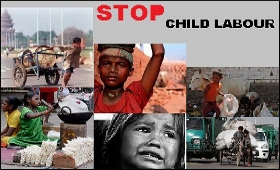|

|
Can child labour be eliminated in India?
|
|

|
|
| Top Stories |
 |
|
|
|
Shweta Sharma | 10 May, 2014
Every day nine-year-old Milli (named changed) rushes through her morning ablutions so that she does not get late. However, unlike other children her age, including her friends, Milli is not racing against time to reach school but her employers' house where she takes care of a girl, less than half her age, along with doing other household chores.
At an age, when most children are seen waiting for their school buses dressed impeccably in their uniforms, Milli, in her worn-down clothes walks past them with hopes and dreams in her eyes.
"I wish I could study like my younger sister. But, mummy says I should help her with this work. I do not argue with her," Milli said. "I hope one day I would."
Milli shares her story with millions of others.
Bhuwan Ribhu, an activist with the Bhachpan Bachao Andolan, or Save the Childhood Movement, said that as per 2010 National Sample Survey Organisation (NSSO) figures, there are close to 4.9 million child labourers in the country.
"As these are government figures, the civil society figures are much higher," he said.
According to the Census 2001 figures there were 12.6 million working children in the age group of five-14 years.
Ribhu said the government argues that with the implementation of the Right to Education (RTE) Act, it has been able to bring down the number of child labour in the nine year period. The RTE Act enacted in 2010 implies that every child in the age group of six to 14 years is entitled to free and compulsory elementary education.
But Vijaylakshmi Arora, director (development support) at Child Rights and You (CRY), said that India does not have "a concrete strategy to prevent child trafficking and also child labour."
According to the International Labour Organisation, there are an estimated 6.8 million boys and 5.8 million girls in child labour in India.
The organisation estimates that globally close to 215 million children between the ages of five and 17 work under conditions that are considered illegal, hazardous, or extremely exploitative.
Ribhu says the biggest employer of children in India is in agriculture followed by domestic households, garment and carpet industries and also bidi and bangle-making.
"A lot of people think that working in agricultural and allied activities is not hazardous. But, we should recognise that the use of pesticides and other chemicals are hazardous for the children," said Arora.
The Child Labour (Prohibition and Regulation) Act, enacted in 1986, prohibits the employment of children in 18 occupations and 65 processes and regulates the working conditions of children in employment where they are not prohibited from working.
"Though the child labour act prohibits employing children up to the age of 14 years, we need to understand that in India, those between the age group of 15-18 years, are as vulnerable," Arora added.
She said that there are many industries in Tamil Nadu, which lure children by offering them lucrative money.
"Schemes like sumangali are common in the state of Tamil Nadu. It is like an organised lobby which involves them in exploitative labour by promising them money at the time of marriage. In Maharshtra, children are taken away by farmers to fields of sweet lime to be used as pluckers," she explained.
Ribhu said that the employing depends on the sector.
"While more girls are employed in agriculture and household activities, rampant trafficking of boys happen for the garment industry. In cotton farming, boys are brought from Rajasthan to work in Gujarat. Similarly, girls from Jharkhand and the northeast are brought as domestic help," said Ribhu.
The problem, according to Sanjay Gupta, director of Chetna, an NGO working for street children "is that there is no pragmatic approach being followed by the government".
"It is the responsibility of the state government to ensure that the children are rescued and given the right kind of rehabilitation. If you are talking about rescue operations, you should first be prepared with the right kind of rehabilitation," Gupta said.
Arora added that a multi-pronged strategy and a strong law that deals with the issue effectively is the need of the hour.
"There should be a high quality, full-time formal education. Even poor parents want their children to be educated. It is also essential to address and identify vulnerable families," she added.
She further mentioned that above all, a belief and commitment to allocate adequate protection for children is needed to fight the cause.
(Shweta Sharma can be contacted at shweta.s@ians.in. The views expressed are personal.)
|
|
|
| |
|
|
|
|
|
|
|
|
|
|
|
|
|
|
| |
| Customs Exchange Rates |
| Currency |
Import |
Export |
US Dollar
|
84.35
|
82.60 |
UK Pound
|
106.35
|
102.90 |
Euro
|
92.50
|
89.35 |
| Japanese
Yen |
55.05 |
53.40 |
| As on 12 Oct, 2024 |
|
|
| Daily Poll |
 |
 |
| Do you think Indian businesses will be negatively affected by Trump's America First Policy? |
|
|
|
|
|
| Commented Stories |
 |
|
|
|
|
|
| |
|